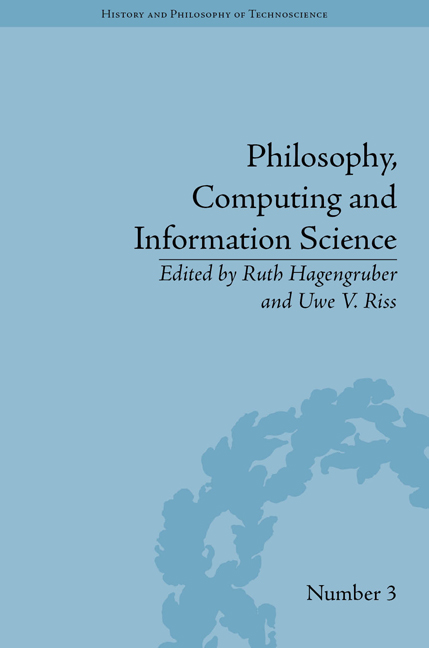Book contents
- Frontmatter
- CONTENTS
- List of Contributors
- List of Figures and Tables
- Introduction: Philosophy's Relevance in Computing and Information Science
- Part I Philosophy of Computing and Information
- 1 The Fourth Revolution in our Self-Understanding
- 2 Information Transfer as a Metaphor
- 3 With Aristotle towards a Differentiated Concept of Information?
- 4 The Influence of Philosophy on the Understanding of Computing and Information
- Part II Complexity and System Theory
- Part III Ontology
- Part IV Knowledge Representation
- Part V Action Theory
- Part VI Info-Computationalism
- Part VII Ethics
- Notes
- Index
2 - Information Transfer as a Metaphor
from Part I - Philosophy of Computing and Information
- Frontmatter
- CONTENTS
- List of Contributors
- List of Figures and Tables
- Introduction: Philosophy's Relevance in Computing and Information Science
- Part I Philosophy of Computing and Information
- 1 The Fourth Revolution in our Self-Understanding
- 2 Information Transfer as a Metaphor
- 3 With Aristotle towards a Differentiated Concept of Information?
- 4 The Influence of Philosophy on the Understanding of Computing and Information
- Part II Complexity and System Theory
- Part III Ontology
- Part IV Knowledge Representation
- Part V Action Theory
- Part VI Info-Computationalism
- Part VII Ethics
- Notes
- Index
Summary
Introduction
An intuitive understanding of information concerns the means by which knowledge is acquired. This notion corresponds to an instantiation of the complementary properties of ‘being informative’ and ‘being informed’. It is in this intuitive sense that the term ‘information’ is used in many accounts of verbal communication and explicit learning. But the term is furthermore prominent in accounts of genetics, neurobiology and cognitive science, as well as in communications engineering, and computer sciences. In view of this transdisciplinary use of the word ‘information’, some theoreticians hope for a unified conception that would serve as a common denominator in interdisciplinary investigations. According to this promise, we would then be equipped with a singular conceptional grasp on physical and genetic structures, on neuronal patterns as well as on cognitive and communicative events. Unfortunately, a unified concept of information is far from being spelled out, since many of the disciplines mentioned above follow quite different approaches. Even in the context of ‘information science’ itself, extensive differences prevail on the notions of data, information and knowledge and their conceptual interconnections. But if we detect not a single but various conceptions of information, we should not expect a single but various theories of information – a point made by Claude Shannon long before the transdisciplinary implementation of his mathematical theory. When one or the other ‘theory of information’ gets implemented into theories of communication or learning, for example, these theories thereby inherit one particular conception of information.
- Type
- Chapter
- Information
- Philosophy, Computing and Information Science , pp. 29 - 40Publisher: Pickering & ChattoFirst published in: 2014



